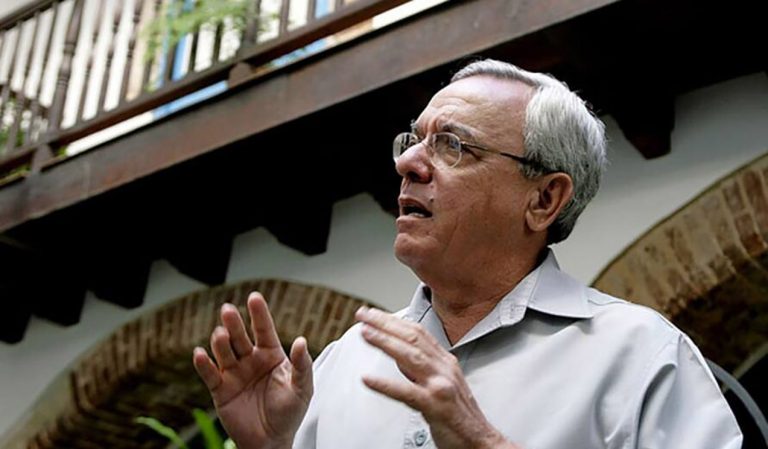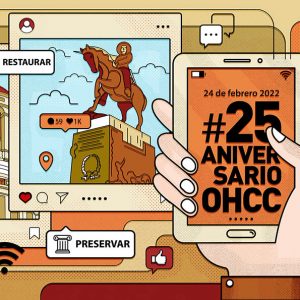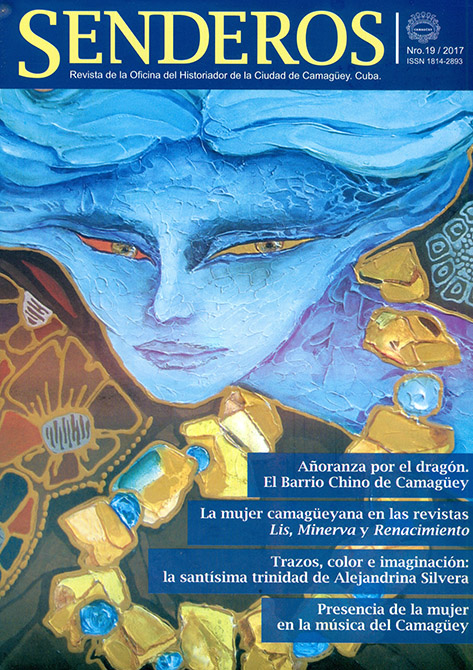From any of the streets of the capital’s historic center he used to be called, either Eusebio, or Leal, the invocation of the first or last name of the main promoter of the restoration of Havana within the walls did not matter.
People calling his name from the heart of Old Havana had a hopeful intention: that if the boards stolen from a bench in Humbolt Park should be quickly restored with his consent; that for how long would the neighbors have to wait for the lighting of the luminaire that kept a sector of Acosta Street in the dark when Leal found out about it, that Eusebio would repaired the sinister Jhonson Pharmacy on Obispo Street as quickly as possible; that the mountain of rubble on Calle Muralla would disappear as soon as the savior of Old Havana acquired the trucks to load this solid waste; that very soon Leal would put a definitive end to the ball game in the old Market Square or Cristina as well as in the gardens of the National Capitol; that Eusebio’s people would repair the spillway in Teniente Rey; that Eusebio would transform the building that once housed the Ministry of Education (with a roof designed for helicopter landing, according to the project carried out in the middle of the Republic) in order to return to Havana the memory of the Royal and Pontifical University, which would be turned into the San Gerónimo School; that Eusebio had the will to rehabilitate the Ambos Mundos Hotel where the famous American writer Hemingwey stayed and to bring life to the dilapidated Martí Theater; that the “tanker truck” belonging tohe Office of the Historian of Havana would solve the shortage of the precious liquid in the oldest area of Havana; that Eusebio would take an old woman to the transit home of his Office before the old building where she lived collapsed; …
Eusebio, or Leal, seemed to have a special gift, the solution to all the ills accumulated for centuries in the capital of all Cubans. How much confidence had the Cuban people in that man!
It was in November 1889 when we met him at the National Center for Conservation, Restoration and Museology (Cencrem, for its acronym in Spanish) in Havana. Those of us who had traveled from the first Cuban villages to the capital to receive training in heritage conservation, we have vivid memories of that man who walked fast through the streets, with overwhelming oratory, dressed in gray, with modesty and proverbial simplicity, the same man that welcomed us with kindness and courtesy, offering us his inaugural lecture of the course in one of the classrooms of the Saint Claire Convent, and on the gray slabs of the floor that cover the graves of some of the nuns of this order.
On that occasion, no one could take notes because Eusebio or Leal talked to fast. As we walked the streets to recognize and admire the history and heritage of Havana, neither the disciple of the Havana’s first historian Emilio Roig de Leuchsenring left room for diverting the attention of those of us who followed him trying to learn from his intellectual genius.
Before each archaeological excavation as he passed the buildings, he would turned to us to reveal the history behind the property, making it seem to those present that he had had time traveled from the past. Everything was explained in detail. We had the privilege of meeting him.
After a while he came to Camagüey, in 1992. In the Birthplace of Mayor Ignacio Agramonte, before starting the meeting he would hold with the highest authorities of the municipality, he had a brief talk with the Camagüey historian Gustavo Sed Nieves and me. He suggested with his usual audacity that it was necessary to make and effort to preserve the wooden altarpiece of the Carmen church, a piece where the image of the saint was painted. Your suggestions were carefully written by me.
Certainly, every time that those from the interior of the country returned to Havana, Eusebio had something new to show. Well, the chapel of the old convent of San Francisco de Paula where the remains of the famous violinist Brindis de Salas rest; the Minor Basilica of the Saint Francis of Assisi convent converted into a concert hall; the Russian Orthodox Church; the Simón Bolívar House, prove of the historical and cultural ties between the homeland of Bolívar and that of José Martí; …
On another occasion we had a new meeting with the historian but this time at the Benito Juárez House of Mexico. It happened while we were taken our regional and local master’s courses at the Institute of Cuban History, in 2006. The conference to pay tribute to the independence of the hero’s homeland was preceded by the ambassador of the United Mexican States, who was followed by the intervention of the PhD. Eusebio Leal Spengler underlining milestones and historical, cultural and political coincidences between Mexico and Cuba. After finishing, the participants from the provinces shook their hands in gratitude for all the knowledge gained. It was fair to thank.
Shortly after, we visited the historian’s offices to receive two essential texts from him: Martí Hombre and the Wedding Album of José Martí and Carmen Zayas-Bazán, works from the Editorial Boloña of the Office of the Historian of Havana.
The first substantial volume that brings us closer to the real human Martí by Gonzalo de Quesada Miranda, son of the Master’s personal assistant, Gonzalo de Quesada y Aróstegui from Camagüey. The texts have Eusebio’s signature and I keep them especially for that reason.
His other gift was his authorization to go to the upper floor, -while it was being restored-, of the old artistic and literary Lyceum of Havana, which brought together the 19th century Cuban Enlightenment in its rooms, and which was visited by the then student of Jurisprudence: Ignacio Agramonte.
One day Eusebio came to Camagüey after making a trip from the heroic city of Santiago de Cuba. He walked through the gallery of the old convent of El Carmen where the headquarters of the Office of the Historian of Camagüey city are located, he came to my door while I was writing, it was at that moment that I looked up and went out to greet him and he reciprocated it. In a very brief dialogue, I told him about my recovery after a surgical intervention, to which he exclaimed in a tone of satisfaction: “I already knew it. Glad you’re well”! I was surprised.
Later, when writing him an email due to the proximity of the date to commemorate the birth of Carlos Manuel de Céspedes, I insisted on the need that we Cubans had to speak more about the Father of the Nation Carlos Manuel de Céspedes. He agreed with me.
And indeed, in Bayamo, from the balcony of the hero’s birthplace, he spoke aloud with greater depth about the Marble Man, as Martí called Céspedes, then he insisted before his statue placed in front of the old Palacio de los Capitanes Generales. Then, at the Cemetery of Santa Ifigenia,located at the heroic city of Santiago de Cuba. He also remembered it again and again in his interviews.
It is true; it is of utmost importance to know every single detail about this historian because his work is the representation of the most profound and purest love for our country. Let us not resort to his death to remind him. Weather Eusebio or Leal, we will keep him alive perennially in Cuban memory. And try to imitate his unquenchable style of work, his lucid thinking about the future, his passion and love for Cuba, his infinite loyalty to the Revolution, his devotion and respect for the history and for the parents of the nation, among whom Martí and Fidel stand out. Eusebio will walk for many centuries.
Translated by: Aileen Álvarez García
____________






